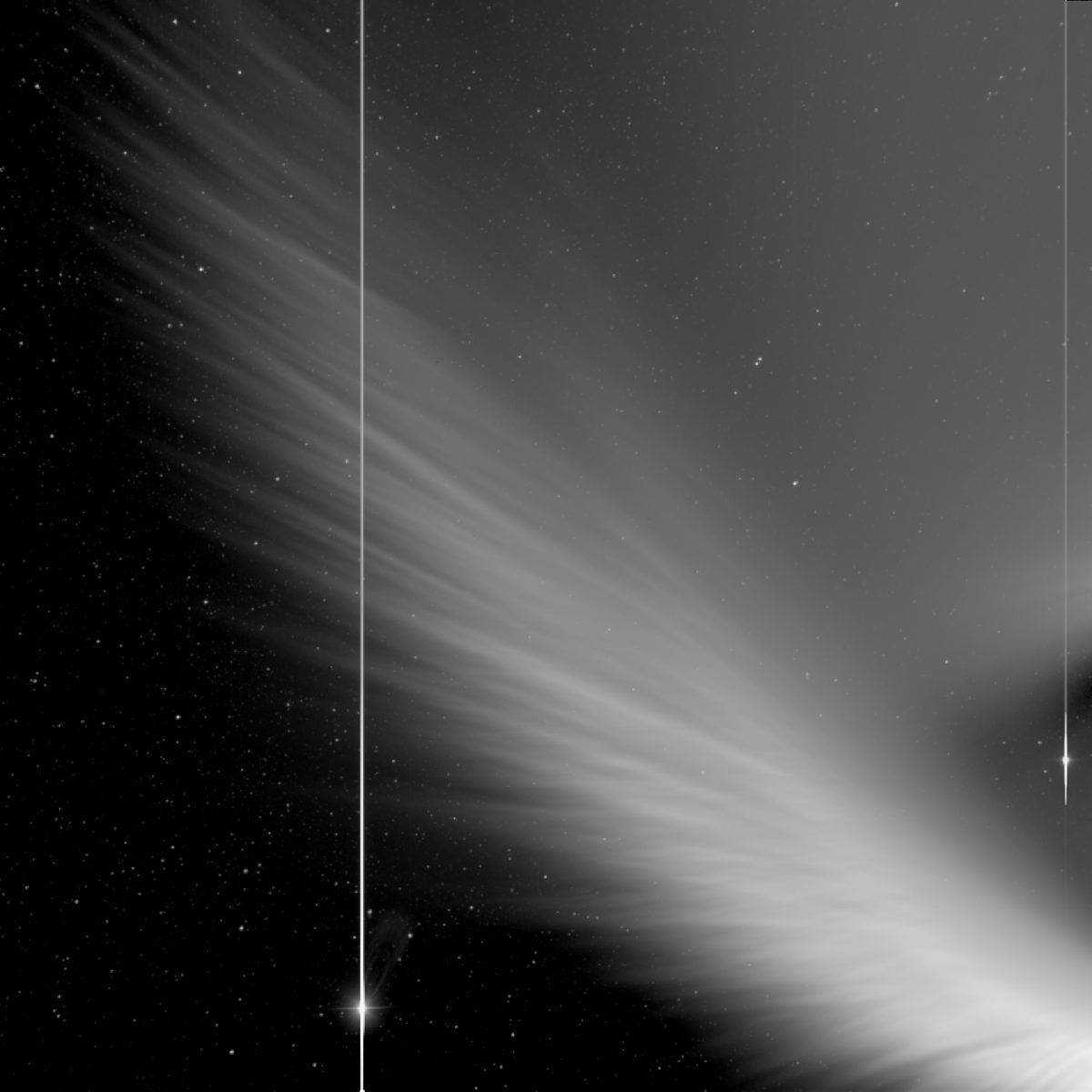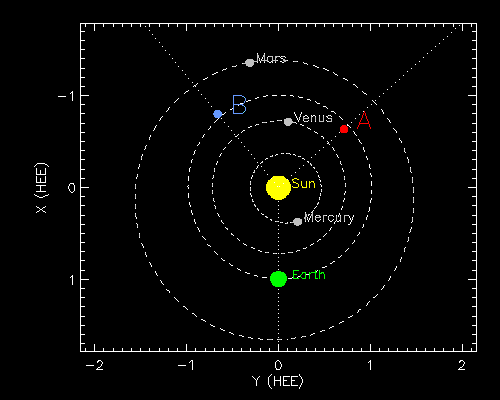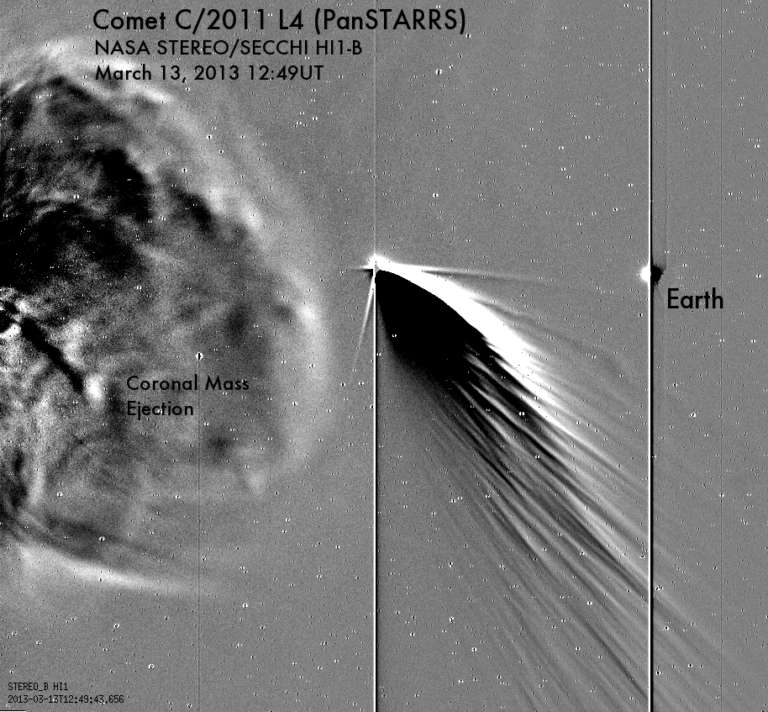Karl Battams • Mar 14, 2013
Comet PANSTARRS from the other side of the Sun!
Across the Northern Hemisphere right now there are very few people who – subject to clear skies – are not afforded the opportunity to see a rare celestial sight in their evening skies: a naked-eye comet! Of course I refer to comet C/2011 L4 (PANSTARRS). Countless photographs of it are now popping up on the Internet as even urban-dwellers such as myself are able to snap a picture of its journey across the skies.
But images of PANSTARRS are not limited to those taken on Earth. I work on the NASA Solar Terrestrial Relations Observatory (STEREO) mission – specifically with the team that built and operate the so-called Sun-Earth Connection Coronal and Heliospheric Imager (SECCHI) instrument package on STEREO. There are two of these satellites, known as STEREO Ahead (“A”) and Behind (“B”), in orbit around the Sun, both carrying identical instruments. As you can see from this orbit overview, they are a both a long way from home now!
Our cameras were designed for watching the Sun itself, and follow its outflow, such as solar wind and coronal mass ejections, through the inner solar system. But we also happen to be able to see more than the occasional comet, and right now Comet PANSTARRS is putting on a spectacular show for the SECCHI Heliospheric Imager-1 (HI-1) camera on the STEREO-B spacecraft!
Of course, we knew PANSTARRS was coming and that we would see it in our images, and we knew how bright it would be as seen from Earth. But STEREO is on the opposite side of the Sun from Earth, and is a tad closer to the comet than we are. That very different viewing geometry meant that we could not really be certain exactly how big, bright and beautiful it was going to be – until now. The answer, in short, is very big, bright and beautiful, as you can see for yourself in this spectacular image of the comet.
Images like this are going to perhaps be a little unfamiliar to many, so I’ll describe what we’re looking at in the images in general, and then I’ll be specific about what we are seeing with the comet. With the SECCHI HI-1 camera we don’t actually see the Sun itself -- it’s outside the left edge of the images. What we do see is all the material flowing out from the Sun, including the solar wind and coronal mass ejections, lots of stars, and planets – including Earth itself! The HI-1 camera has a very high level of sensitivity to faint features, but that also means we do suffer from saturated pixels around bright objects (the bright vertical lines). Here's a video made of more HI-1 images:
The raw images returned from HI-1 are inherently rather ugly, if I’m honest, and so in order to make them presentable and the features in them visible, we always have to do a certain degree of processing. We have many ways of doing this, and depending on what feature we want to study we will choose a different processing method. The one I’ve chosen here is really great at picking out details in the comet, but does unfortunately make stars in the image look rather strange, often with little black dots in them, and leaves large black areas around the comet where it is over-compensating for brightness. Alternative views of the comet look much prettier in general, but make it harder to see the details we, as scientists, are interested in. Finally, on the left, we see a medium-size coronal mass ejection (CME) blasting out into the images. While it looks like it’s on a collision course with the comet, indications are that it did NOT hit it (remember, we’ve viewing a huge region of space there!).
So that’s a very quick introduction to the images themselves -- now what about the comet? Hopefully you’ve watched the movie by now and have seen the spectacular “finger-like” structures in the large dust tail; we call those striae. The origin of striae is rather complicated and still not yet enormously well-understood, but it appears to be a combination of things. I’ve had several questions about this, so at the risk of getting too wordy, I’m going to elaborate just a little on what they are. Primarily they’re made of fine dust grains being pushed out of the comet’s orbit by radiation pressure. Based on modeling, we think these particles come from larger grains that leave the rotating comet nucleus and then fragment into smaller grains a day, or three, later. These finer grains then spread out and become subject to radiation pressure from the Sun, with the lighter grains being most affected. The end result is the long dusty lines that we observe in the tail of the comet (and have seen before). The best analogy I can think of is a garden sprinkler on a windy day. The sprinkler head slowly releases big droplets of water that will then at some later time disperse into mist, at which point the wind picks up the mist and blows it away. The analogy is a tad flawed, but not horribly so.

What you might also notice in the PANSTARRS movie is that there’s actually more than one tail on this comet. In fact, there are at least three! The first one is the big dust tail I just spoke about, and by far the dominant feature of the comet. But if you watch the movie again we can see a short spikey tail pointing towards the lower-left of the images. This is very likely to be another dust tail, but one composed of very large and heavy pieces of cometary material that are not so easily influenced by the solar wind or radiation pressure. Instead, they’re big enough that they simply continue to follow the comet in its orbit, rather than being pushed outwards by other forces. Many of the higher-quality images taken from Earth also show this tail.
In addition to those two dust tails, on the right of the comet nucleus we see a thin third tail pointing radially away from the Sun. This is an “ion” or “gas” tail and is the result of the solar wind ionizing the neutral gas in the comet’s coma and releasing a stream of ions pointing directly away from the Sun. Interestingly, these ions can be highly affected by magnetic fields, and it just so happens that the solar outflow in general contains a very complicated and highly variable magnetic field. The result of this is that we frequently see twists and turns in the ion tail of comets, particularly in our STEREO images. Actually, though, PANSTARRS' ion tail is holding very steady. This might be a hint that it is composed of slightly more “exotic” ions than we typically see; perhaps Fe+, but we are going to need to turn to our computer models to figure that out!
Comet PANSTARRS will remain visible in the STEREO-B HI-1 data until around March 19, and all the data will be made freely available online at our SECCHI website and at the main STEREO Science Center site. Unfortunately, the orbit of PANSTARRS means it is going to pass outside the field of view of all the other cameras we have available on both the STEREO spacecraft, and on the Solar and Heliospheric Observatory (SOHO) satellite, so the data returned from STEREO HI-1B images are all we’ll have for this comet. Later this year, though, we could get to see one of the brightest comets in a century – C/2012 S1 (ISON) -- pass through all of our imagers on SOHO and STEREO. We need to wait a few more months before we know for sure how it’s going to perform, but it has the potential to completely overshadow what we’re currently witnessing with Comet PANSTARRS! Stay tuned!
Support our core enterprises
Your support powers our mission to explore worlds, find life, and defend Earth. You make all the difference when you make a gift. Give today!
Donate

 Explore Worlds
Explore Worlds Find Life
Find Life Defend Earth
Defend Earth



